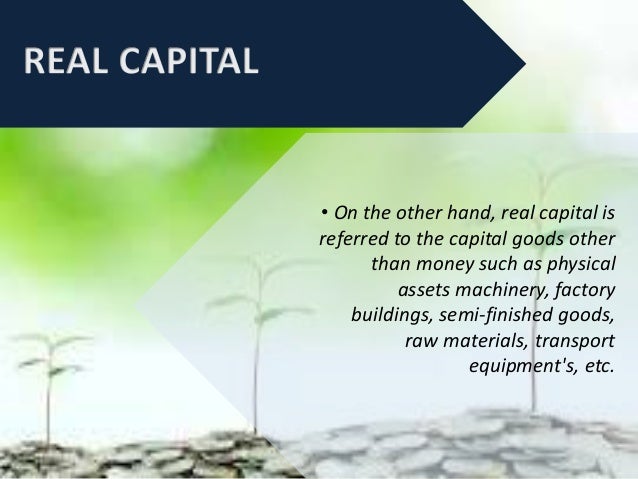- Real Capital Vs Money Capital Investment
- Real Capital Vs Money Capital Management
- Real Capital And Money Capital
- Is Money Capital
- Is Money Considered Capital
- Real Capital Vs Money Capital Investment
Real Capital Vs Money Capital Investment
A tale of two ticker tapes: Annaly down, MFA Financial nearly out. Annaly stock closed on March 12 at $8.74 per share after hitting a 52-week high of $8.87 earlier in the day, completing its. Financial Capital vs. Economic Capital: An Overview. Money raised from debt and equity issues is normally referred to as capital. However, the word 'capital' has many different meanings in.
Much confusion in economics results from the common practice of referring to money as capital. In fact money and capital are two different things. Capital is the real resources that producers use in order to make the goods that we all consume: things like factories, machine tools, trucks, and roads. All capital exists in a specific form. Money on the other hand is non-specific; it can be used to buy anything that is available in the marketplace, including capital goods. This is what leads to the common practice of referring to money as capital. Keynesian economists say that new money cannot cause inflation or other problems because the economy is not at “full employment” or that we have “excess capacity.” I have dealt with the question of “full employment” elsewhere; this article intends to address the issue of “excess capacity.”
In a nutshell “excess capacity” cannot exist because capital goods are specific, they can be used only to engage in a certain type of production. In order to use new money to produce the goods that will be demanded in the future, existing capital must be transformed or new capital goods must be produced. All of this takes time.

The basic error that occurs as a result of this process is the idea that by adding money to the economy, we can increase current consumption while at the same time setting aside more resources as capital goods to be used to produce for the future. The critical factor that this assumption leaves out is time. It takes time for a given sum of money to enter the market and transform into actual capital goods that can be used for future production. At the time the money is added to the economy, a set amount of capital exists. Increasing the money supply does not increase this amount, it simply allows those who have access to the new money to buy up some of the existing resources and use them. What they use them for depends entirely on who gets the new money first.
In our current system, new money is given to big banks and Wall Street firms. These firms then lend the money to entrepreneurs who actually produce the goods that we consume. Even if the recipient of newly printed money knows of a factory that is not being used, or other “excess” capital, he must still go onto the market and buy that resource, find people who know how to work with the machines in the factory (or train them), and find a market for the products that his factory will produce. These are all risky endeavors. Entrepreneurs evaluate risk based on the interest rate.
When new money forces interest rates down near zero, more risky investments are tried. Projects that are started at a time of loose money and low interest rates tend to fail once the central bank stops printing money and interest rates rise, making things that seemed profitable at the old rates now appear to be losers. These marginal investments that are only possible due to manipulated interest rates are what are known as “mal-investments.” It is the failure of these mal-investments which leads to the sudden business failures at the beginning of every depression or recession. Every boom-bust cycle follows this pattern: new money is printed, interest rates fall, marginal investments are made, the amount of money printing declines, interest rates rise, mal-investments are exposed, people lose their jobs and investors lose money. The loss of jobs and money causes supply and demand to fall, initiating another recession.
The attribution of the recession to a “fall in demand” misses the point. Demand is a result of production and wealth generation. People can only demand consumer goods if they have first produced something which they can offer in exchange for the products that they demand. Attempting to stimulate demand by printing money and lowering interest rates can only lead to a repeat of the boom-bust cycle and to more mal-investments that will eventually have to be liquidated, causing a repeat of the entire process.
How is a termination payment for a failed real estate deal taxed? Does it trigger capital or ordinary gain? The court recently addressed this in CRI-Leslie, LLC v. Commissioner, 147 T.C. 8.
Facts & Procedural History
The taxpayer owned a Radison-branded hotel in Florida. It entered into a contract to sell the hotel to a third party. The contract fell thru and the taxpayer was entitled to keep the deposit money the would-be buyer had provided. The taxpayer reported the deposit as long term capital gain on its income tax return. An IRS audit resulted in litigation over whether the deposit was capital or ordinary gain for Federal income tax purposes.
Capital vs. Ordinary Gain or Loss
Our tax laws make a distinction between investment and business assets. Investment assets are generally referred to as capital assets. Business assets are generally referred to as ordinary assets.
Real Capital Vs Money Capital Management
Once there is a sale or other exchange of the asset, the characterization of the asset as capital or ordinary dictates what tax rate applies to the gain or loss. The idea is that capital or investment assets should be taxed at a lower rate than ordinary or business assets.

There are also rules that specify whether gains and/or losses from the sale or exchange of capital and ordinary assets can offset each other. The rules are somewhat involved and there are a myriad of nuanced rules.
Real Capital And Money Capital

Section 1231 is an example. It says that gain from the sale or exchange of certain business assets is capital and losses from the sale or exchange of certain business assets is ordinary. This can result in the gain from the sale or exchange being able to offset capital losses. If there is a loss from the sale or exchange, it can result in the loss being able to offset other business income. So the gain is capital and the loss is ordinary under Section 1231.
Section 1234A
Section 1234A applies to payments received due to cancellation, lapse, expiration, or other termination of a contract.
Earnest money that is forfeited in a real estate transaction that does not close is an example. Section 1234A says that the gain or loss received due to cancellation, lapse, expiration, or other termination of a contract for capital assets is capital in nature. So the gain or loss is capital under Section 1234A.
Termination Payments are Ordinary Gain
This brings us to the taxpayer’s argument in CRI-Leslie. The taxpayer argued that its gain was capital in nature even though the asset that was sold was not a capital asset. More specifically, the taxpayer argued that Section 1234A applies to Section 1231 gain–as Section 1231 treats gains as capital gains.
The taxpayer noted that this would be good tax policy as it would harmonize the results if the taxpayer had sold the property, as the gain would have been capital due to Section 1231. So it would seem that the termination payment should also be capital gain.
Is Money Capital
The IRS argued that Section 1234A does not mention Section 1231. It only mentions capital assets. So the IRS’s position was that Section 1234A did not apply to convert the income to capital gain.
Is Money Considered Capital
The court agreed with the IRS, even though doing so could produce odd results. The court recognized the “disparate treatment,” noting that:
Forfeited deposits from the termination of a contract to sell [a business asset] are taxed at capital gain rates if the [business asset] is held as a passive investment. The same forfeited deposits are taxed as ordinary income if the [business asset] is used in a trade or business.
The court reached this conclusion based on a strict reading of Section 1234A, as advocated for by the IRS. It concluded that the code section is not ambiguous even though it can produce odd results.
The Takeaway
The takeaway is that taxpayers and their advisors need to take a second look at how they have and are characterizing termination payments. This is particularly true for those taxpayers who are currently under audit or whose returns are about to be audited.
Related Articles
Real Capital Vs Money Capital Investment
- Appropriate a Book of Business, Capital or Ordinary Gain?
- Real Estate Purchase Price Reduction
- Sale of Lottery Payments, Capital or Ordinary?
- Litigation Award for Damage to Dairy Farm Ordinary Not Capital
- Real Estate Professionals Subject to Material Participation Rules